Diary Entry: Improving Communication Skills in Healthcare Module
VerifiedAdded on 2021/05/30
|5
|1159
|337
Journal and Reflective Writing
AI Summary
This diary entry reflects on a student's experience in a healthcare module focused on effective communication. The student utilized the Gibbs reflective model to document and analyze their progress in interpersonal communication skills, particularly in interactions with clients. The entry details the initial challenges with team interactions and confidence, the application of communication theories like Mehrabian's rule, and the importance of non-verbal and paraverbal communication. The student reflects on the need for better preparation, improved communication with the team, and the value of understanding clients' backgrounds and beliefs. The assignment highlights the practical application of communication skills within health and social care, emphasizing the critical role of effective communication in understanding client needs and building rapport. The student also references key literature on communication models and skills.
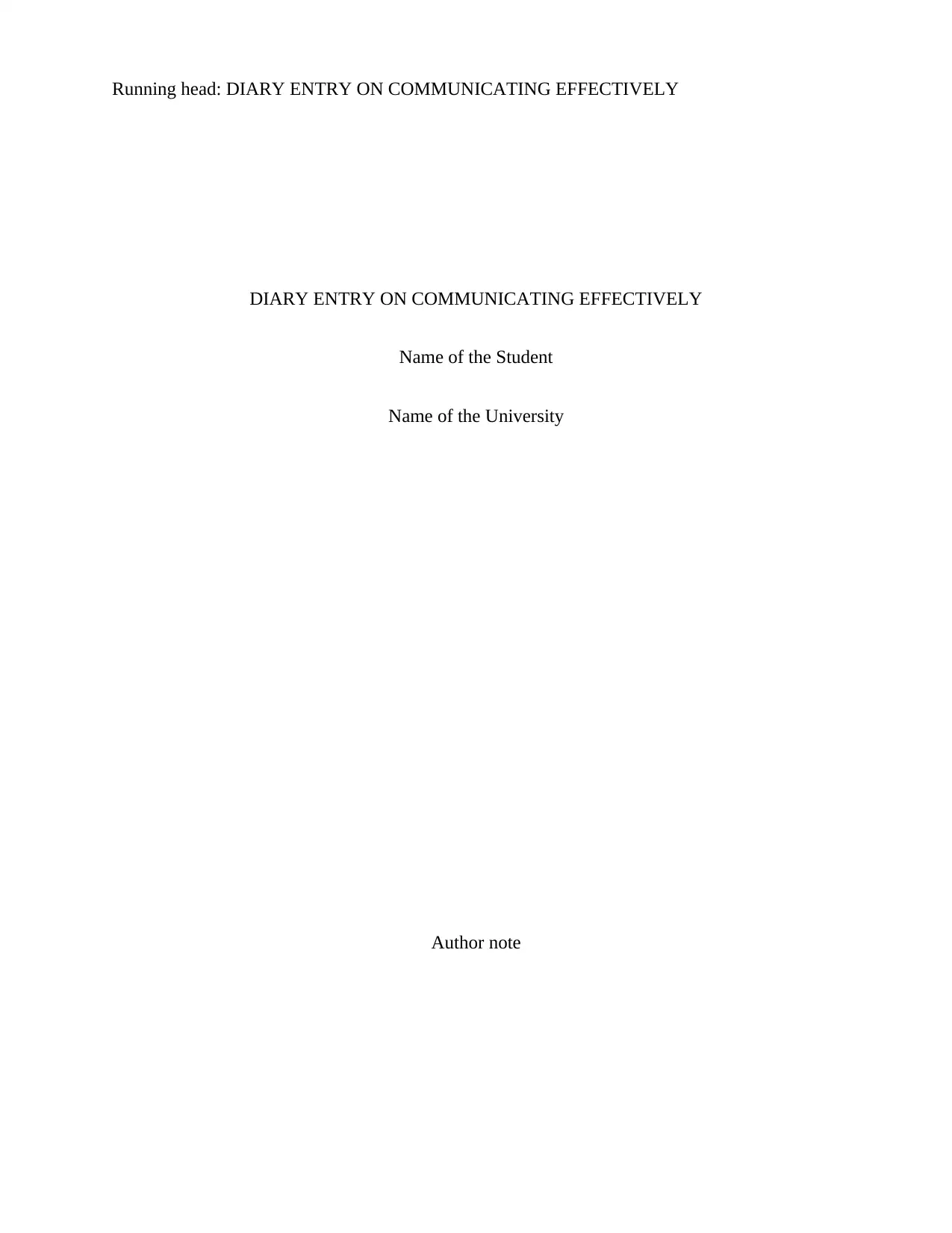
Running head: DIARY ENTRY ON COMMUNICATING EFFECTIVELY
DIARY ENTRY ON COMMUNICATING EFFECTIVELY
Name of the Student
Name of the University
Author note
DIARY ENTRY ON COMMUNICATING EFFECTIVELY
Name of the Student
Name of the University
Author note
Paraphrase This Document
Need a fresh take? Get an instant paraphrase of this document with our AI Paraphraser
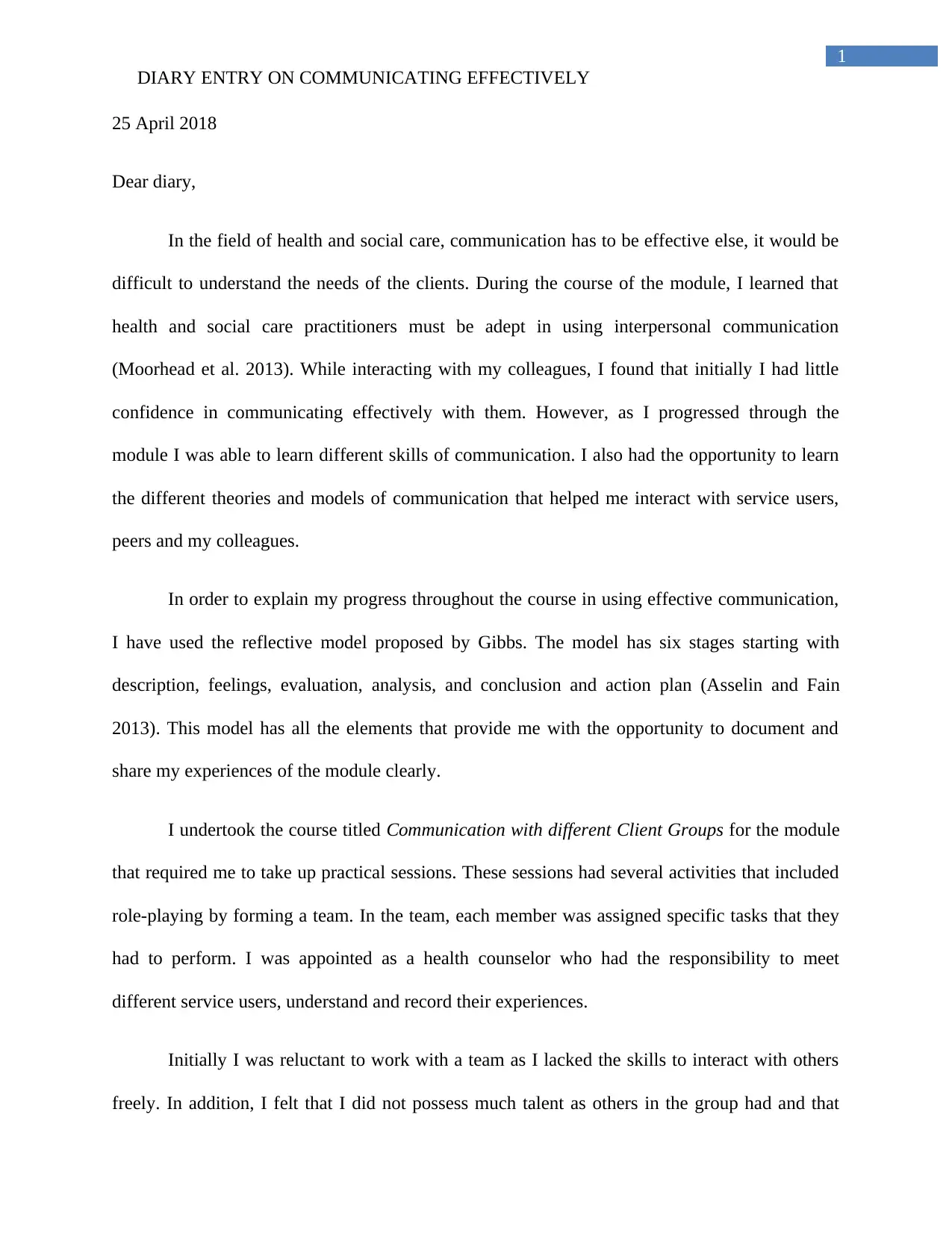
1
DIARY ENTRY ON COMMUNICATING EFFECTIVELY
25 April 2018
Dear diary,
In the field of health and social care, communication has to be effective else, it would be
difficult to understand the needs of the clients. During the course of the module, I learned that
health and social care practitioners must be adept in using interpersonal communication
(Moorhead et al. 2013). While interacting with my colleagues, I found that initially I had little
confidence in communicating effectively with them. However, as I progressed through the
module I was able to learn different skills of communication. I also had the opportunity to learn
the different theories and models of communication that helped me interact with service users,
peers and my colleagues.
In order to explain my progress throughout the course in using effective communication,
I have used the reflective model proposed by Gibbs. The model has six stages starting with
description, feelings, evaluation, analysis, and conclusion and action plan (Asselin and Fain
2013). This model has all the elements that provide me with the opportunity to document and
share my experiences of the module clearly.
I undertook the course titled Communication with different Client Groups for the module
that required me to take up practical sessions. These sessions had several activities that included
role-playing by forming a team. In the team, each member was assigned specific tasks that they
had to perform. I was appointed as a health counselor who had the responsibility to meet
different service users, understand and record their experiences.
Initially I was reluctant to work with a team as I lacked the skills to interact with others
freely. In addition, I felt that I did not possess much talent as others in the group had and that
DIARY ENTRY ON COMMUNICATING EFFECTIVELY
25 April 2018
Dear diary,
In the field of health and social care, communication has to be effective else, it would be
difficult to understand the needs of the clients. During the course of the module, I learned that
health and social care practitioners must be adept in using interpersonal communication
(Moorhead et al. 2013). While interacting with my colleagues, I found that initially I had little
confidence in communicating effectively with them. However, as I progressed through the
module I was able to learn different skills of communication. I also had the opportunity to learn
the different theories and models of communication that helped me interact with service users,
peers and my colleagues.
In order to explain my progress throughout the course in using effective communication,
I have used the reflective model proposed by Gibbs. The model has six stages starting with
description, feelings, evaluation, analysis, and conclusion and action plan (Asselin and Fain
2013). This model has all the elements that provide me with the opportunity to document and
share my experiences of the module clearly.
I undertook the course titled Communication with different Client Groups for the module
that required me to take up practical sessions. These sessions had several activities that included
role-playing by forming a team. In the team, each member was assigned specific tasks that they
had to perform. I was appointed as a health counselor who had the responsibility to meet
different service users, understand and record their experiences.
Initially I was reluctant to work with a team as I lacked the skills to interact with others
freely. In addition, I felt that I did not possess much talent as others in the group had and that
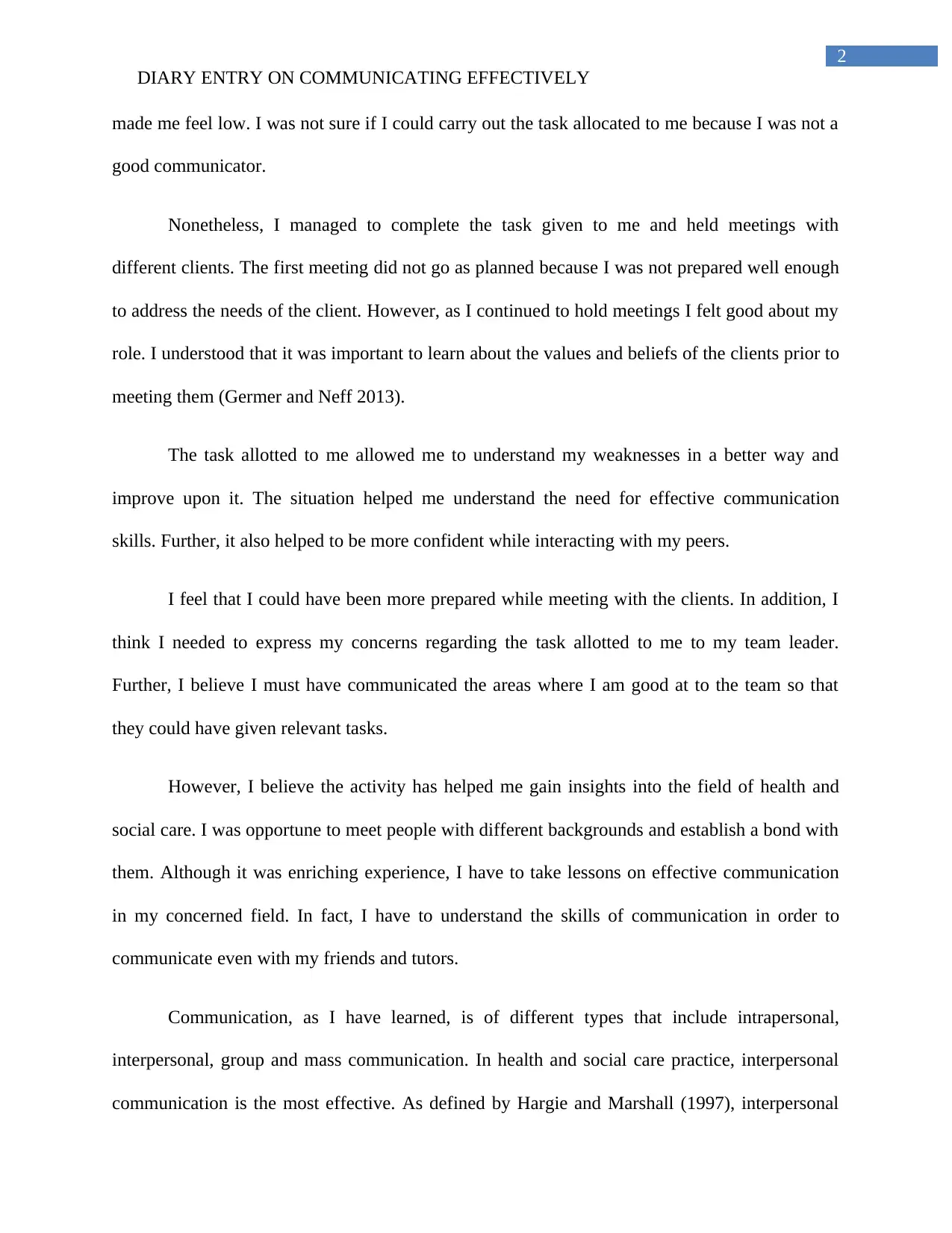
2
DIARY ENTRY ON COMMUNICATING EFFECTIVELY
made me feel low. I was not sure if I could carry out the task allocated to me because I was not a
good communicator.
Nonetheless, I managed to complete the task given to me and held meetings with
different clients. The first meeting did not go as planned because I was not prepared well enough
to address the needs of the client. However, as I continued to hold meetings I felt good about my
role. I understood that it was important to learn about the values and beliefs of the clients prior to
meeting them (Germer and Neff 2013).
The task allotted to me allowed me to understand my weaknesses in a better way and
improve upon it. The situation helped me understand the need for effective communication
skills. Further, it also helped to be more confident while interacting with my peers.
I feel that I could have been more prepared while meeting with the clients. In addition, I
think I needed to express my concerns regarding the task allotted to me to my team leader.
Further, I believe I must have communicated the areas where I am good at to the team so that
they could have given relevant tasks.
However, I believe the activity has helped me gain insights into the field of health and
social care. I was opportune to meet people with different backgrounds and establish a bond with
them. Although it was enriching experience, I have to take lessons on effective communication
in my concerned field. In fact, I have to understand the skills of communication in order to
communicate even with my friends and tutors.
Communication, as I have learned, is of different types that include intrapersonal,
interpersonal, group and mass communication. In health and social care practice, interpersonal
communication is the most effective. As defined by Hargie and Marshall (1997), interpersonal
DIARY ENTRY ON COMMUNICATING EFFECTIVELY
made me feel low. I was not sure if I could carry out the task allocated to me because I was not a
good communicator.
Nonetheless, I managed to complete the task given to me and held meetings with
different clients. The first meeting did not go as planned because I was not prepared well enough
to address the needs of the client. However, as I continued to hold meetings I felt good about my
role. I understood that it was important to learn about the values and beliefs of the clients prior to
meeting them (Germer and Neff 2013).
The task allotted to me allowed me to understand my weaknesses in a better way and
improve upon it. The situation helped me understand the need for effective communication
skills. Further, it also helped to be more confident while interacting with my peers.
I feel that I could have been more prepared while meeting with the clients. In addition, I
think I needed to express my concerns regarding the task allotted to me to my team leader.
Further, I believe I must have communicated the areas where I am good at to the team so that
they could have given relevant tasks.
However, I believe the activity has helped me gain insights into the field of health and
social care. I was opportune to meet people with different backgrounds and establish a bond with
them. Although it was enriching experience, I have to take lessons on effective communication
in my concerned field. In fact, I have to understand the skills of communication in order to
communicate even with my friends and tutors.
Communication, as I have learned, is of different types that include intrapersonal,
interpersonal, group and mass communication. In health and social care practice, interpersonal
communication is the most effective. As defined by Hargie and Marshall (1997), interpersonal
⊘ This is a preview!⊘
Do you want full access?
Subscribe today to unlock all pages.

Trusted by 1+ million students worldwide
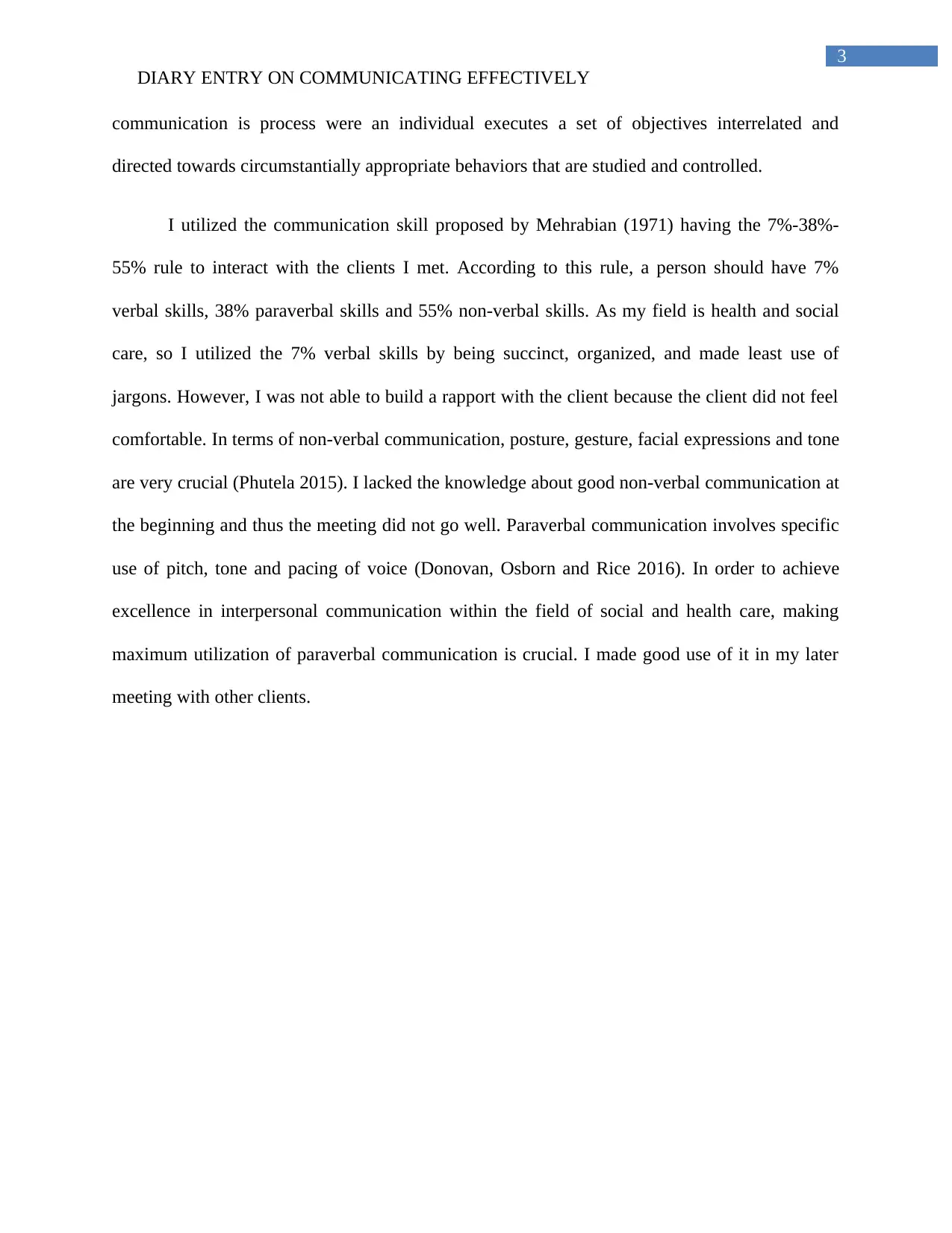
3
DIARY ENTRY ON COMMUNICATING EFFECTIVELY
communication is process were an individual executes a set of objectives interrelated and
directed towards circumstantially appropriate behaviors that are studied and controlled.
I utilized the communication skill proposed by Mehrabian (1971) having the 7%-38%-
55% rule to interact with the clients I met. According to this rule, a person should have 7%
verbal skills, 38% paraverbal skills and 55% non-verbal skills. As my field is health and social
care, so I utilized the 7% verbal skills by being succinct, organized, and made least use of
jargons. However, I was not able to build a rapport with the client because the client did not feel
comfortable. In terms of non-verbal communication, posture, gesture, facial expressions and tone
are very crucial (Phutela 2015). I lacked the knowledge about good non-verbal communication at
the beginning and thus the meeting did not go well. Paraverbal communication involves specific
use of pitch, tone and pacing of voice (Donovan, Osborn and Rice 2016). In order to achieve
excellence in interpersonal communication within the field of social and health care, making
maximum utilization of paraverbal communication is crucial. I made good use of it in my later
meeting with other clients.
DIARY ENTRY ON COMMUNICATING EFFECTIVELY
communication is process were an individual executes a set of objectives interrelated and
directed towards circumstantially appropriate behaviors that are studied and controlled.
I utilized the communication skill proposed by Mehrabian (1971) having the 7%-38%-
55% rule to interact with the clients I met. According to this rule, a person should have 7%
verbal skills, 38% paraverbal skills and 55% non-verbal skills. As my field is health and social
care, so I utilized the 7% verbal skills by being succinct, organized, and made least use of
jargons. However, I was not able to build a rapport with the client because the client did not feel
comfortable. In terms of non-verbal communication, posture, gesture, facial expressions and tone
are very crucial (Phutela 2015). I lacked the knowledge about good non-verbal communication at
the beginning and thus the meeting did not go well. Paraverbal communication involves specific
use of pitch, tone and pacing of voice (Donovan, Osborn and Rice 2016). In order to achieve
excellence in interpersonal communication within the field of social and health care, making
maximum utilization of paraverbal communication is crucial. I made good use of it in my later
meeting with other clients.
Paraphrase This Document
Need a fresh take? Get an instant paraphrase of this document with our AI Paraphraser
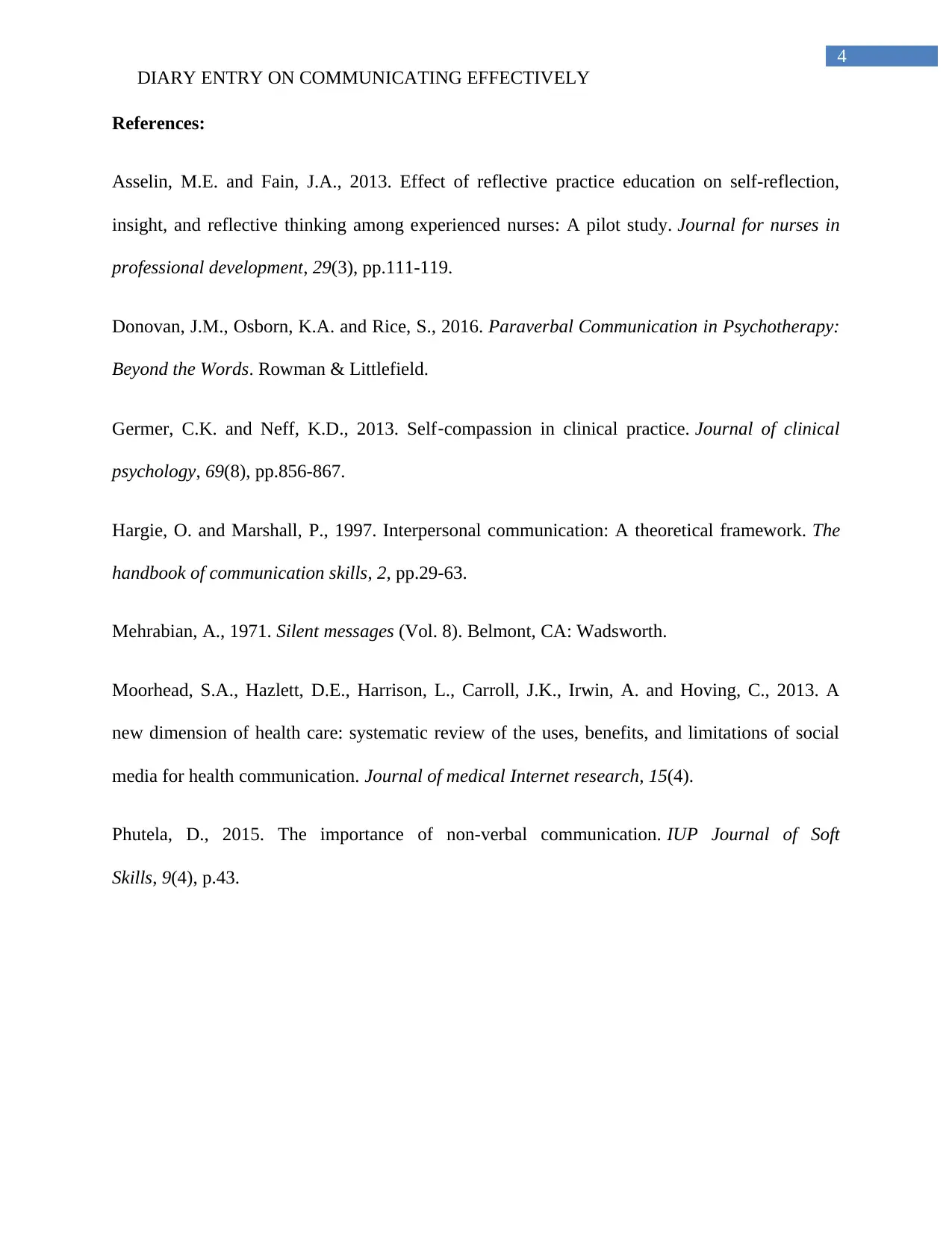
4
DIARY ENTRY ON COMMUNICATING EFFECTIVELY
References:
Asselin, M.E. and Fain, J.A., 2013. Effect of reflective practice education on self-reflection,
insight, and reflective thinking among experienced nurses: A pilot study. Journal for nurses in
professional development, 29(3), pp.111-119.
Donovan, J.M., Osborn, K.A. and Rice, S., 2016. Paraverbal Communication in Psychotherapy:
Beyond the Words. Rowman & Littlefield.
Germer, C.K. and Neff, K.D., 2013. Self‐compassion in clinical practice. Journal of clinical
psychology, 69(8), pp.856-867.
Hargie, O. and Marshall, P., 1997. Interpersonal communication: A theoretical framework. The
handbook of communication skills, 2, pp.29-63.
Mehrabian, A., 1971. Silent messages (Vol. 8). Belmont, CA: Wadsworth.
Moorhead, S.A., Hazlett, D.E., Harrison, L., Carroll, J.K., Irwin, A. and Hoving, C., 2013. A
new dimension of health care: systematic review of the uses, benefits, and limitations of social
media for health communication. Journal of medical Internet research, 15(4).
Phutela, D., 2015. The importance of non-verbal communication. IUP Journal of Soft
Skills, 9(4), p.43.
DIARY ENTRY ON COMMUNICATING EFFECTIVELY
References:
Asselin, M.E. and Fain, J.A., 2013. Effect of reflective practice education on self-reflection,
insight, and reflective thinking among experienced nurses: A pilot study. Journal for nurses in
professional development, 29(3), pp.111-119.
Donovan, J.M., Osborn, K.A. and Rice, S., 2016. Paraverbal Communication in Psychotherapy:
Beyond the Words. Rowman & Littlefield.
Germer, C.K. and Neff, K.D., 2013. Self‐compassion in clinical practice. Journal of clinical
psychology, 69(8), pp.856-867.
Hargie, O. and Marshall, P., 1997. Interpersonal communication: A theoretical framework. The
handbook of communication skills, 2, pp.29-63.
Mehrabian, A., 1971. Silent messages (Vol. 8). Belmont, CA: Wadsworth.
Moorhead, S.A., Hazlett, D.E., Harrison, L., Carroll, J.K., Irwin, A. and Hoving, C., 2013. A
new dimension of health care: systematic review of the uses, benefits, and limitations of social
media for health communication. Journal of medical Internet research, 15(4).
Phutela, D., 2015. The importance of non-verbal communication. IUP Journal of Soft
Skills, 9(4), p.43.
1 out of 5
Related Documents
Your All-in-One AI-Powered Toolkit for Academic Success.
+13062052269
info@desklib.com
Available 24*7 on WhatsApp / Email
![[object Object]](/_next/static/media/star-bottom.7253800d.svg)
Unlock your academic potential
Copyright © 2020–2025 A2Z Services. All Rights Reserved. Developed and managed by ZUCOL.





